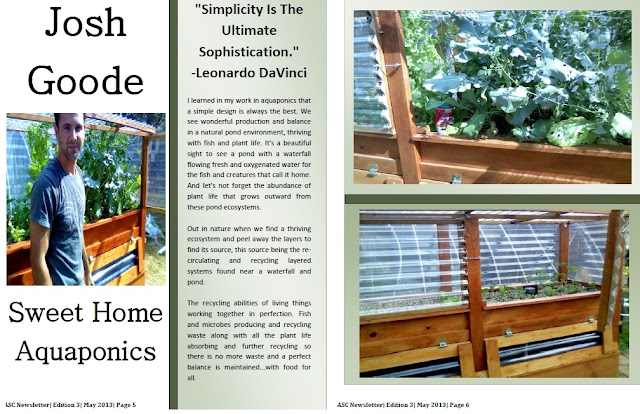Aqua Abundance and Spencer Curry
Spencer Curry is an owner-operator with Fresh Farm Aquaponics. He is also a writer for the ASC Magazine. Spencer's articles come with a lot of enthusiasm and love for this industry. We are very proud to feature this column in our magazine every month. Spencer is showing people of all ages what can be done with all of that youth and energy. We think he is quite a remarkable young man.
Hi everyone welcome back to Aquaponic Abundance!
Article taken from the ASC Magazine March 2015
Last time we talked we went over the specific winter techniques that I’m using on my farm, FRESH Farm Aquaponics. We're located in South Glastonbury, Connecticut.
Currently we have more than a couple feet of snow piled up around our greenhouse. Despite night temperatures well below freezing, our 25 koi are happily swimming in balmy 65 degrees water with daily air temperatures of 75-80℉.
We went over how we heat the water (with a Jacuzzi heater), our mini-greenhouses, and the lights we use to accelerate growth during the darker months. Be sure to check out last month’s article for more information.
This month the light starts to come back and the days grow longer. Our plants are starting to perk up and grow, little by little.
The aquaponics system is a marvelous tool for season extension. Even without using grow lights, there are a number of benefits to starting your season off early with an aquaponics system.
Season Extension with Aquaponics
There are many reasons aquaponics is so wonderful for season extension. Aquaponics systems use heat more efficiently, the growing media is always workable and they make use of the little light available most effectively.
Most farmers in our region are busy hibernating at this time of the year. Fields are under thick blankets of snow. Greenhouses are expensive to heat the traditional way, most farmers around here use wood boilers or oil burning ovens to keep their greenhouse air warm.
But as we covered in the last article, it is far more cost-effective to heat the water in the aquaponics system than heating the air in a normal greenhouse. For one, the heat from the water eventually radiates up to the plants leaves.
This is similar to how the heat of the Earth normally radiates up from the soil into the undercarriage of the plants. By heating the water, you heat the roots and plants and the air, all at a fraction of the cost of heating the air by itself!
Eager to get planting but held back by a snowy March?
Luckily, aquaponics growing media is also always workable. The growing medium never freezes. There is no need to wait for soil to thaw out. There is no need to shovel snow or wait for it to melt.
No need to battle early spring weeds or any of the other headaches typically associated with working the land after a hard winter. That means that you can get your plants in the ground as soon as the seedlings are ready.
Finally, aquaponics provides such a rich environment to your new seedlings that they are able to best utilize whatever light there is available in these early months. In normal soil conditions, plant roots must expend energy on extending themselves throughout the soil in search of nutrients.
However in aquaponics, the roots are flooded with vital nutrients, water, and beneficial bacteria.
There is no need to expend resources on root growth, so all energy is directed to actual plant growth. When a plant has so much of its needs cared for, the only limiting factor is the light. That means that whatever light is available, your aquaponics systems will make the best of it!
If you would like to read more about the Aqua Abundance Article...
Subscribe to the magazine by purchasing a lifetime subscription here:
OR
You can purchase all the back issues of the ASC Magazine here:










